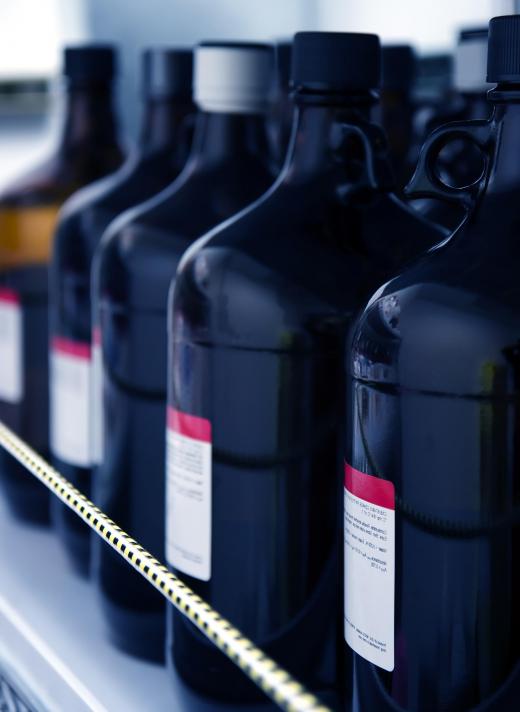What is Methanol?
Methanol is the simplest alcohol compound, consisting of one carbon atom and three hydrogen atoms arranged as a methyl group (CH3), which is joined to an oxygen and a hydrogen atom in a hydroxyl group (OH), giving the chemical formula CH3OH. It may be referred to as methyl alcohol, wood alcohol, or by the obsolete term carbinol. The compound differs from ethanol — the type of alcohol found in beers, wines and spirits — and is toxic. It is a colorless, tasteless, flammable liquid that is quite volatile and has a slight smell. Methanol is used in many industrial processes, in some types of antifreeze, as a fuel, and in the production of biodiesel.
Uses

The compound is widely used as a raw material in the production of other chemicals, particularly formaldehyde, which in turn is used in the production of plastics. It is added to ethanol intended for industrial or household cleaning purposes, as opposed to drinking, to render it undrinkable. This avoids the taxes payable on alcoholic drinks. The resulting product is known as denatured alcohol, or methylated spirit, and typically contains about 10% methanol. Methyl alcohol is also an ingredient in some antifreeze mixtures, in windshield wiper fluid, and is used as a solvent in various paints and varnishes.

A growing application of methyl alcohol is as a fuel, either directly, or in the manufacture of biodiesel. It has been used in pure form for some time in top-end racing engines, drag racers and in radio-controlled model airplanes, but it is being advocated as a viable alternative to fossil fuels for more general use. Like fossil fuels, methanol produces carbon dioxide during combustion, but has the advantage that it can be manufactured cheaply from renewable resources. It also burns more cleanly than fuels such as gasoline, as it does not produce smoke, soot, or large amounts of harmful hydrocarbon compounds.

In the methanol economy, this compound would be the common fuel, with non-renewable fuels having a minority share or not being used at all. The Nobel Prize winning chemist George Olah is a strong advocate of this path. Proponents point out that methyl alcohol is relatively cheap to produce, can be manufactured with little or no waste, is efficient to store, and can be made from sources other than fossil fuels. Also, while conversion to a hydrogen economy would require major changes in infrastructure, methanol could be phased in relatively easily as it can be mixed with fossil fuels such as gasoline to produce hybrid fuels while making the shift.

Potential drawbacks include the fact that methyl alcohol is corrosive to some metals, especially aluminum. This would make it necessary to replace some storage tanks, pipelines and engine parts. It is also more toxic than many other commonly used fuels, including gasoline.
Instead of using the compound as a fuel in itself, methanol can be used to produce biodiesel, which can be burned in some diesel vehicles without expensive modifications to the engine. The methyl alcohol is heated with vegetable oil, along with sodium or potassium hydroxide, which acts as a catalyst. This process turns the vegetable oil into smaller molecules that are more suitable as fuel, and produces glycerol as a by-product.
Toxicity

Humans can tolerate very small amounts of methyl alcohol — which is in fact present in tiny quantities in some foods — without becoming ill, as the body is able to rid itself of this harmful chemical to some extent, but in larger amounts, it is toxic. In the body, it is converted into formaldehyde and formates, which are damaging to cells. In particular, they can affect the optic nerve, and interfere with vision. Swallowing a third of a fluid ounce (about 10 milliliters) or less could cause blindness, and one or two fluid ounces (30 – 60 milliliters) could prove fatal. Methanol poisoning may occasionally result from accidental swallowing, but another possible route is through the intentional drinking of methylated spirit as a cheap alternative to alcoholic drinks.
Manufacture
Traditionally, methyl alcohol has been produced by the combining of carbon monoxide and hydrogen, and by reacting methane with steam. Both processes are carried out under pressure and using catalysts, and usually the raw materials have come directly or indirectly from fossil fuels. To reduce reliance on these fuels, however, the production of methanol from biomass has expanded significantly. Biomass can be vegetable material grown specifically for this purpose or a variety of plant-based waste materials. It is broken down into carbon monoxide and hydrogen, which is then used to produce the alcohol.
AS FEATURED ON:
AS FEATURED ON:















Discussion Comments
How can methanol be used in perfume production. What are its functions and what other chemical can be used as a substitute?
to FB-214580040: no it doesn't. it produces butanol.
does methanex produce methanol?
Why do some wholesalers add methanol to the wine since they know that it is very toxic and they will be arrested if they sell it? I hope you will answer my question.
A very good article that is sure to help us with our presentation. ps: not sure about that 'anon18330.'
Is it okay to mix methanol ethanol and gasoline??
HPLC is usually reverse-phase, so the stationary phase is nonpolar. This makes the polar mobile phase and more polar substances being analyzed elute faster. Methanol is less polar than water, but more polar than organic solvents. Thus, using it in place of water will decrease elution time of nonpolar compounds, which will dissolve in methanol better than in water. In gradient elutions, say with a water/methanol mobile phase with increasing methanol concentration, the more polar compounds being analyzed will come out first, and the less polar compounds will emerge as the methanol concentration increases. Acetonitrile is used for the same purpose.
why do we use methanol in mobile phase for HPLC?
Post your comments